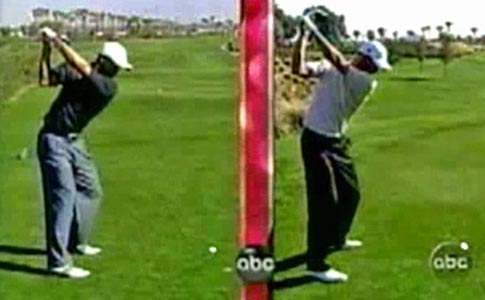Golf Master Tips - The disadvantage of Ryan Moore's backswing action is that he has to employ a compensatory move to get to the desired end-backswing position (image 4). I think that it is advantageous to learn how to perform a backswing action that gets the hands to their desired end-backswing position (image 4) whilesimultaneously keeping the clubshaft on-plane throughout the backswing - by using a right forearm takeaway.
I described the right forearm takeaway in great detail in my How to Move the Arms, Wrists and Hands in the Golf Swing review paper. One of the key features of a right forearm takeaway backswing action is the "biomechanical requirement" to bend (dorsiflex) the right wrist backwards while keeping the right wrist level (not allowing the right wrist to cock upwards).
Disadvantage of Ryan Moore's Backswing
The fundamental biomechanical principle that a golfer needs to understand is the biomechanical principle that allows a golfer to cock the left wrist upwards in the backswing without having to simultaneously cock the right wrist upwards.
The biomechanical phenomenon that allows the left wrist to cock upwards (without the right wrist cocking upwards) is the biomechanical fact that the right elbow bends (folds) to a 90 degree angle in the backswing.
It is the bending/folding of the right elbow that allows/causes the left wrist to cock upwards, and during this biomechanical action the right wrist only bends backwards (dorsiflexes) without necessarily cocking upwards.
In other words, the bending of the right elbow allows the directional motion of the right wrist to be perpendicular to the directional motion of the left wrist - the right wrist moves in a horizontal plane (hinging plane of dorsiflexion) while the left wrist moves in a vertical plane (cocking plane of radial deviation).
The fact that the right wrist moves in a plane of motion that is perpendicular to the plane of motion of the left wrist is a critically important fact, and this biomechanical phenomenon allows a golfer to get the right forearm flying wedge to be roughly perpendicular to the left arm flying wedge by the end of the backswing (analogous to the supporting wing strut of a small Cessna airplane supporting the airplane wing).

Tiger Woods and Adam Scott's end-backswing position - capture images from their swing video
Note how the clubshaft is at a 90 degree angle to the left arm at the end-backswing position with the clubshaft being straight-in-line with the left arm - this represents the left arm flying wedge.
Note that the right forearm flying wedge is angled at roughly a 90 degree angle to the left arm flying wedge, and this is only biomechanically possible because the right wrist is bent backwards while the right elbow is bent/folded to roughly a 90 degree angle.
Note that both Tiger Woods and Adam Scott have their left arm roughly across their shoulder turn angle - similar to Ryan Moore in image 4.
Ben Hogan recommended this backswing action in his book [3] and he used the following diagram to make his point.

Ben Hogan's glass plane image - from reference number [3]
Ben Hogan advised golfers in his book to have a shallow left arm backswing action that ensured that the left arm never broke through the imaginary pane of glass during the backswing. I think that most modern professional golfers - like Tiger Woods - are following Ben Hogan's advice, and a key learning principle is learning how to assemble the power package (loaded left arm flying wedge and loaded right forearm flying wedge) below that imaginary glass plane. To achieve that goal, it is important not to allow the right wrist to cock upwards during the mid-backswing (while the right elbow is folding).
Look at this swing vide of Ben Hogan's swing and note how his right wrist bend backwards (dorsiflexes) without cocking upwards during his backswing. http://www.youtube.com/watch?v=QL_6M_xZvq0
Here is a link to another superb golfer, John Erickson, who has a similar swing - where the left arm doesn't crash through the imaginary pane of glass. http://www.youtube.com/watch?v=Bh5wZ0J8rXU
Note that John Erickson's right wrist bends backwards (dorsiflexes) without cocking upwards. Both golfers (Ben Hogan and John Erickson) use the right forearm takeaway, rather than the one-piece takeaway, during their backswing - note how close their right elbow remains in relationship to their right torso in the backswing and note how soon the right elbow starts bending/folding in the backswing.
By contrast, Tiger Woods and many professional golfers, use an one-piece takeaway. Both the one-piece takeaway (which I described in my backswing chapter) and the right forearm takeaway (which I described in my How to Move the Arms, Wrists and Hands in the Golf Swing review paper) are perfectly acceptable backswing takeaway actions and they both assemble the power package assembly (left arm flying wedge and right forearm flying wedge) correctly at the end-backswing position.
I prefer the right forearm takeaway because I think that it allows the arms to remain more "connected" to the body during the backswing, and there is less risk of having the arms move in a disconnected manner relative to the rotating torso. I also think that it is easier to keep the clubshaft on-plane using the right forearm takeaway, and it is also easier for the arms/hands to follow the same arm/hand arc path in the downswing.
Golfers, who use the one-piece takeaway, have a very wide arm/clubshaft arc in the backswing, and a much narrower arm/clubshaft path in the downswing. (Source)


0 komentar:
Post a Comment